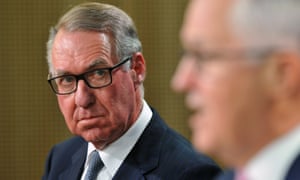
David Gonski and Malcolm Turnbull announce ‘Gonski 2.0’ on Tuesday. Photograph: Joel Carrett/AAP
From the Gillard government’s six-year needs-based school funding agreements to Malcolm Turnbull’s Gonski 2.0: how has the federal government proposed changing the funding of schools?
How much is the federal government spending on schools?
Canberra will spend $17.5bn this year on schools. With increases every year between 2017 and 2027, this will rise to $22.1bn in 2021 and $30.6bn in 2027.
It will spend a total of $81.1bn over four years (2018 to 2021) and $242.3bn over 10 years (2018 to 2017). Compared with the 2016 budget, Tuesday’s announcement amounts to a $2bn increase over four years and $18.6bn increase over 10 years.
However, compared with Labor’s arrangements it is still $6.3bn less over four years and $22.3bn less over 10 years.
How much do individual schools get?
School funding is set as a proportion of the schooling resource standard (SRS). The base amount in 2018 is $10,953 for a primary student and $13,764 for a secondary student.
On Tuesday the government announced that by 2027 the commonwealth would give:
- All government schools 20% of the SRS, up from 17%
- All non-government schools 80% of the SRS, up from 77%
While it seems odd that the federal government provides a higher share to non-government schools, that is because state governments are the main funders of public schools.
Over 10 years 41.6% of federal funding will go to the government sector and 58.4% to the non-government sector.
Schools also continue to receive loadings above the base standard to provide support for students from low socio-economic or non-English speaking backgrounds, with disability, or from smaller regional or remote schools.
Which schools will have their funding cut?
It depends what you mean by “cut”.
If you mean “receive less money than the previous year” the answer is 24. Just 24 schools in Australia will “experience some negative growth” as the education minister, Simon Birmingham, described it on Tuesday.
But if you mean “receive less than they were due to get under the Gillard government six-year needs-based funding agreements” then the answer is likely to be many more.
On Sky on Wednesday Birmingham confirmed that 353 “overfunded” non-government schools would have “lower rates of growth as we transition to that common point” of the commonwealth providing 80% of the SRS.
“Because it’s happening over a steady 10-year period, indexation means they won’t necessarily go backwards … They might grow in nominal terms but not necessarily in real terms over that 10-year period.”
He said more than 9,000 schools would receive a funding increase. Birmingham said that no public schools were on the list of 353 “overfunded” schools.
The government has also set aside $39.8m over 10 years for “adjustment assistance” including temporary additional support for ACT non-government schools, suggesting an attempt to knock the hard edges off reductions in funding trajectory.
In order to accelerate the trajectory towards the SRS for underfunded schools, the funding for government schools will grow by an average of 94% from 2018 to 2027, compared with funding for non-government schools which will increase by 62%.
Why the change?
The Turnbull government has argued that if Labor’s schools funding agreements were adhered to, it would take too long for some schools to reach the SRS and others who had already reached it would continue to see their funding grow.
That’s because Labor promised all schools – including the most “overfunded” – would get guaranteed 3% growth in funding every year.
According to a government factsheet by 2019 only 116 schools would have reached 100% of the SRS with 9,018 still below the standard. Of those, about 5,524 would still be below 95% of the SRS and underfunded by an average of $458,000 a school.
By 2027, 6,966 schools would still have been below the full SRS by an average of approximately $690,000.
And after all this things will settle down a bit, yeah?
Hmm maybe not. The policy commits the government to honour its 2016 budget commitment to grow the funding standard at 3.56% from 2018 to 2020, which is higher than real cost growth.
But beyond that? “From 2021, a floating indexation rate will be applied to the funding standard to ensure that funding will reflect real changes in costs and stay in line with the economy,” the policy states.
Also, David Gonski will conduct a second review, to report back by December, on achieving educational excellen
[“Source-theguardian”]












